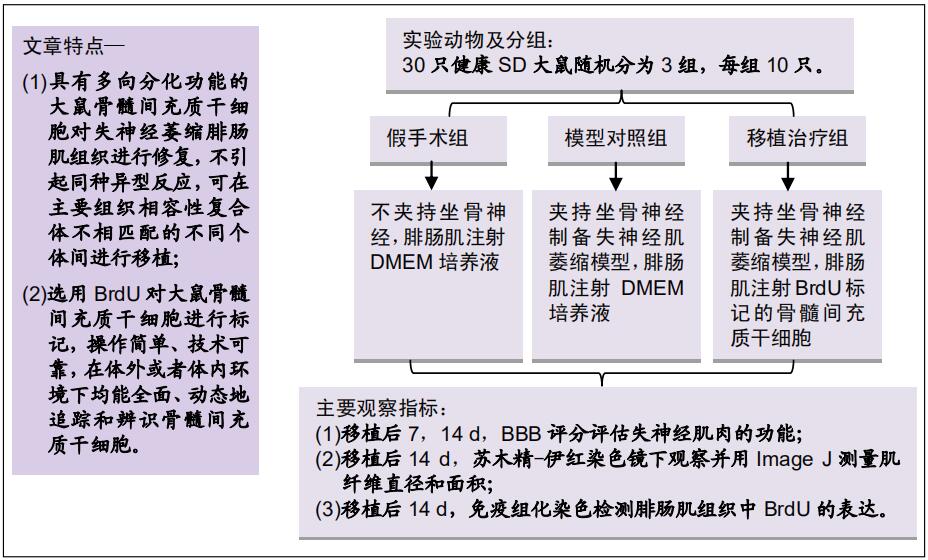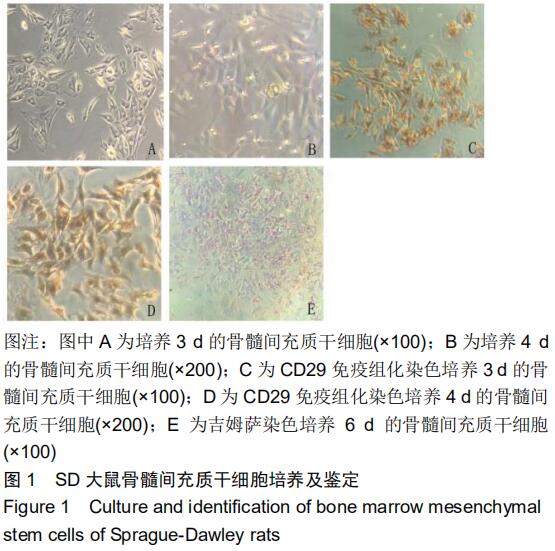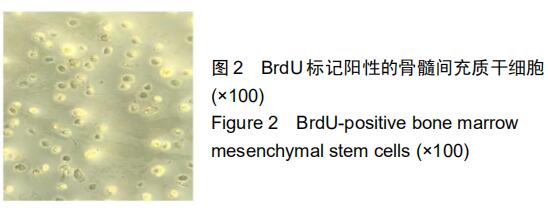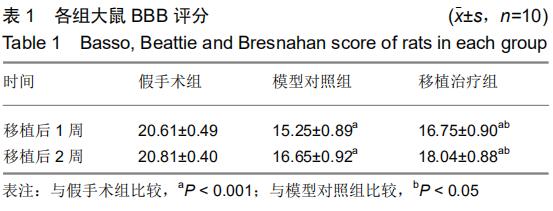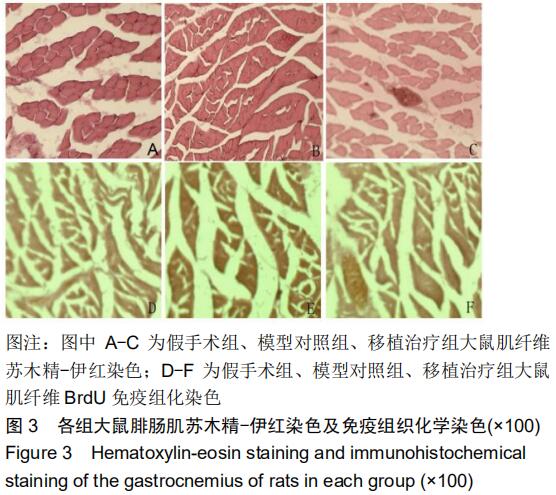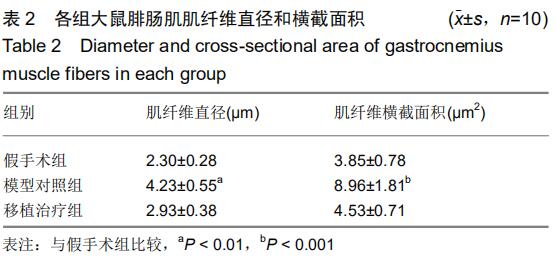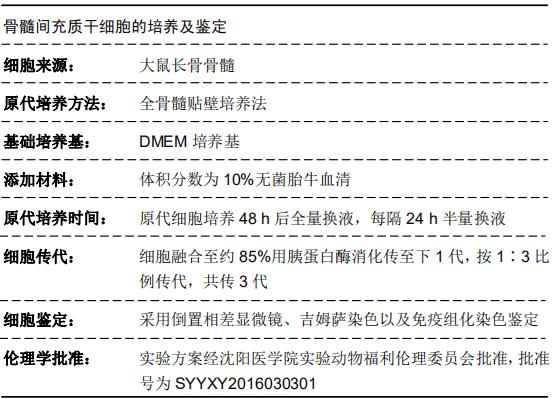|
[1] SAMII A, CARVALHO GA, SAMII M. Brachial plexus injury: factors affecting functional outcome in spinal accessory nerve transfer for the restoration of elbow flexion. J Neurosurg. 2003;98(2):307-312.
[2] 顾立强,裴国献.周围神经损伤基础与临床[J].北京:人民军医出版社,2001: 70,157.
[3] DASARI VR, VEERAVALLI KK, TSUNG AJ, et al. Neuronal apoptosis is inhibited by cord blood stem cells after spinal cord injury. J Neurotrauma. 2009;26(11):2057-2069.
[4] 吴佳佳,徐建光,马书杰.失神经骨骼肌萎缩的机制及康复治疗[J].安徽医药, 2017,21(11):1949-1953.
[5] 贺菊芳,余资江,戈果,等.大鼠坐骨神经损伤手术时机选择的实验研究[J].贵州医科大学学报,2016,41(10):1122-1127.
[6] 董英,徐昂,姜影,等.运动训练结合针刺对坐骨神经损伤大鼠肌力和神经纤维恢复的影响[J].滨州医学院学报, 2016,39(5):327-329.
[7] 马书杰,严隽陶,黄品贤,等.推拿手法防治失神经骨骼肌萎缩的实验研究[J].江苏中医药,2014,46 (11):79-81.
[8] 刘磊.电刺激对失神经骨骼肌萎缩中核因子-КB、肌肉环状指蛋白-1表达变化的影响[J].北方药学,2013,10 (8):81.
[9] 裴艳宏,刘坤祥.黄芪丹参联合对大鼠失神经骨骼肌萎缩的作用[J].中国医学工程,2013,21 (9):5-6.
[10] 付秀美,王荣良,杨海艳,等.脂肪源性干细胞对大鼠坐骨神经功能恢复的影响[J].承德医学院学报,2016,33(6):451-453.
[11] 贺菊芳,余资江.神经干细胞移植治疗周围神经损伤的研究进展[J].贵州医科大学学报,2016,41(10):1117-1121.
[12] 蔡学华,吕艳丽.坐骨神经损伤修复机制及治疗效果评价[J].双足与保健, 2017,26(23):112,114.
[13] 方洪松,周建林,彭昊,等.不同来源间充质干细胞生物学特性差异[J].中国组织工程研究,2015,19(32):5243-5248.
[14] 蒲超,张珊珊,李伟,等.犬骨髓间充质干细胞体外分离培养及分化鉴定[J].川北医学院学报,2016,31(6):782-785.
[15] 杨俊丽,韩霞,孙明启,等.兔骨髓间充质干细胞的生物学特征及原代培养[J].中国组织工程研究,2015,19(50):8043-8047.
[16] 李丹,张金国.大鼠骨髓间充质干细胞体外培养体系的建立[J].济宁医学院学报,2015,38(5):321-323.
[17] 宋珂,石琦,青莹,等.大鼠骨髓间充质干细胞分离培养及鉴定的相关研究[J].临床口腔医学杂志,2015,31(9):531-536.
[18] 易敏,付必莽,李志伟,等.兔骨髓间充质干细胞的培养及初步鉴定[J].昆明医科大学学报,2015,36(9):17-19.
[19] 阮光萍,刘菊芬,王金祥,等.鸡卵清提取液促进C57小鼠骨髓间充质干细胞增殖的研究[J].西南国防医药,2015,25(8):826-828.
[20] DOCHEVA D, POPOV C, MUTSCHLER W, et al. Human mesenchymal stem cells in contact with their environment: surface characteristics and the integrin system. J Cell Mol Med. 2007;11(1):21-38.
[21] ZAPPIA E, CASAZZA S, PEDEMONTE E, et al. Mesenchymal stem cells ameliorate experimental autoimmune encephalomyelitis inducing T-cell anergy. Blood. 2005;106(5):1755-1761.
[22] LI Y, CHEN J, CHEN XG, et al. Human marrow stromal cell therapy for stroke in rat: neurotrophins and functional recovery. Neurology. 2002; 59(4):514-523.
[23] SASAKI M, RADTKE C, TAN AM, et al. BDNF-hypersecreting human mesenchymal stem cells promote functional recovery, axonal sprouting, and protection of corticospinal neurons after spinal cord injury. J Neurosci. 2009;29(47):14932-14941.
[24] CARONI P. Activity-sensitive signaling by muscle-derived insulin-like growth factors in the developing and regenerating neuromuscular system. Ann N Y Acad Sci. 1993;692:209-222.
[25] 王佃亮,李燕妮.间充质干细胞移植治疗作用机制[J].转化医学杂志, 2019, 8(5):257-261.
[26] 黄华, Raynald,安沂华,等. 移植人骨髓间充质干细胞促进大鼠脊髓损伤后的神经功能恢复[J].武警后勤学院学报(医学版), 2016,25(11):865-868.
[27] 冯烨军,陈明.骨髓间充质干细胞在神经修复中的研究进展[J].神经损伤与功能重建,2016,11(5):426-428.
[28] 刘晓光,肖卫华,赵淋淋,等.间充质干细胞移植治疗骨骼肌损伤的研究进展[J].中国康复医学杂志,2015,30(12):1313-1317.
[29] 肖恒军,转黎,陈俊,等.大鼠骨髓间充质干细胞体外定向诱导分化成平滑肌细胞[J].中国男科学杂志,2015,29(9):3-6.
[30] 黄蓉,梁瑜祯,卢炳丰,等.自体骨髓间充质干细胞移植促进缺血下肢血管新生的实验研究[J].医学研究生学报, 2015,28(7):706-710.
[31] 刘青峰,王葳,王亿龙.骨髓间充质干细胞移植对放射性肠损伤大鼠的修复作用及对JAK/STAT通路的影响[J].中国药物与临床, 2018,18(2):163-166.
[32] 王灵战,王立群,孟壮志,等.大鼠比目鱼肌肌纤维总数、横截面积及其内慢肌纤维和快肌纤维横截面积与年龄相关的变化[J].解剖学报,2015,46(5): 660-666.
[33] 罗涛,王彤敏,李力燕.EdU与BrdU在检测细胞增殖中的特点及应用进展[J].重庆医学,2015,44(32):4581-4583.
[34] 高黎,祝华,张荣,等.BrdU标记人脐带间充质干细胞及对细胞生物学行为影响的体外研究[J].重庆医科大学学报, 2014, 39(11):1617-1621.
[35] 许伟,谢兴文,赵永利,等.Brdu标记的rBMSCs在大鼠体内的迁移[J].中国骨质疏松杂志,2015,21(4):409-414.
[36] ZAIM M, KARAMAN S, CETIN G, et al. Donor age and long-term culture affect differentiation and proliferation of human bone marrow mesenchymal stem cells. Ann Hematol. 2012;91(8):1175-1186.
[37] 张明鸣,贾贵清,程惊秋,等.大鼠骨髓间质干细胞的BrdU体外标记和体内示踪研究[J].四川大学学报(医学报), 2012,43(2):266-270.
[38] MEYER JS, KOEHM SL, HUGHES JM, et al. Bromodeoxyuridine labeling for S-phase measurement in breast carcinoma. Cancer. 1993; 71(11):3531-3540.
[39] CUEVAS P, CARCELLER F, DUJOVNY M, et al. Peripheral nerve regeneration by bone marrow stromal cells. Neurol Res. 2002;24(7): 634-638.
[40] 陈菁,楚燕飞,顾玉东,等.培养雪旺细胞 NGF、CNTF 和 GDNF 共表达和共定位实验研究[J].中华手外科杂志, 2005,21(5):317-319.
[41] 邱超,郑亚妮,许硕贵.骨髓间充质干细胞移植对周围神经损伤后施旺细胞的影响[J].组织工程与重建外科杂志, 2018,14(1):28-30.
[42] 田春艳,潘月彩.神经生长因子治疗周围神经损伤的临床价值分析[J].中国医药指南,2016,14(36):152-153.
[43] 蔡明轩,颜南,王正东,等.神经细胞分泌因子促进骨骼肌细胞生长[J].中国组织工程研究,2016,20(42):6324-6329.
[44] NAKAMURA Y, MIYAKI S, ISHITOBI H, et al. Mesenchymal-stem-cell- derived exosomes accelerate skeletal muscle regeneration. FEBS Lett. 2015;589(11):1257-1265.
[45] 李鹏,郭修田.骨髓间充质干细胞成肌分化在骨骼肌再生中的应用[J].中华细胞与干细胞杂志,2018,8(3):187-191.
[46] 侯晓乐,李爱国,杨林,等.骨髓间充质干细胞移植对失神经肌肉萎缩大鼠的影响[J].新乡医学院学报,2015,32(5):391-394.
[47] KIM SS, YOO SW, PARK TS, et al. Neural induction with neurogenin1 increases the therapeutic effects of mesenchymal stem cells in the ischemic brain. Stem Cells. 2008;26(9):2217-2228.
|
